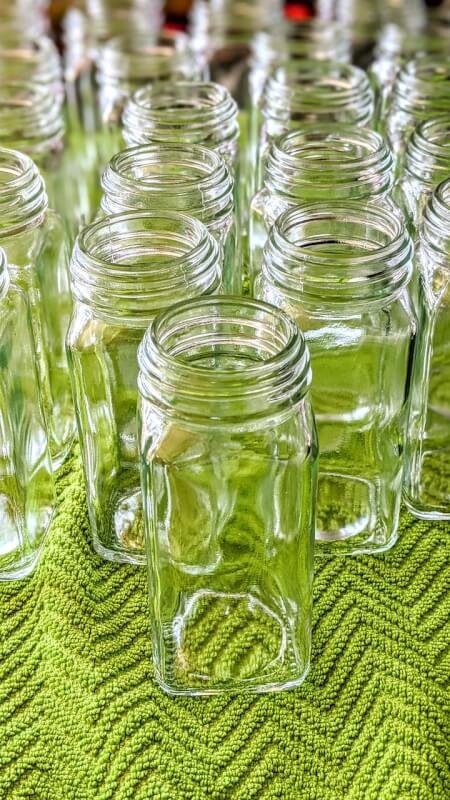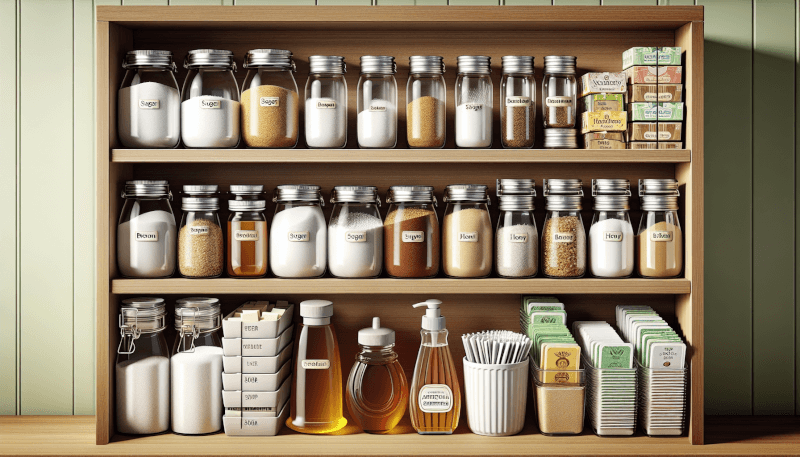Imagine never having to worry about running out of sugar or sweeteners again. Whether you’re a baking enthusiast or just someone who loves their morning coffee with a touch of sweetness, having a long-term supply of these essentials is a game-changer. In this article, we’ll explore the best practices for storing bulk sugar and sweeteners to ensure their freshness and quality are preserved for extended periods. From proper packaging to ideal storage conditions, you’ll find all the tips and tricks you need to stock up and stay prepared. So let’s jump right in and discover how you can have your sugar, and sweeteners too, without any worries!

Choosing the Right Containers
Selecting the Appropriate Containers
When it comes to storing bulk sugar and sweeteners for long term use, choosing the right containers is crucial. Opt for containers that are specifically designed for food storage. Look for containers made of food-grade materials such as BPA-free plastic, glass, or stainless steel. These containers are non-reactive and won’t leach harmful chemicals into your sweeteners. Additionally, choose containers with tight-fitting lids to ensure airtight storage and prevent moisture from seeping in.
Avoiding Containers with Odors
It is important to avoid using containers that have lingering odors, as sweeteners can easily absorb these odors and affect their taste and quality. Before storing your sugar and sweeteners, make sure to thoroughly clean the containers and remove any remnants of previous stored items. A simple solution of warm water and mild dish soap can do the trick. Rinse the containers well and allow them to air dry completely before transferring your sweeteners.
Using Airtight Containers
To maintain the freshness and quality of your bulk sugar and sweeteners, it is essential to use airtight containers. Airtight containers prevent air and moisture from entering the storage space, thus preventing spoilage and clumping of the sweeteners. Make sure the lids fit tightly and create a secure seal when closed. This will not only extend the shelf life of your sweeteners but also help preserve their flavor.
Labeling the Containers
To avoid any confusion and make your storage system more organized, it is highly recommended to label your containers. Labeling allows you to easily identify the type of sweetener stored in each container, especially if you have different types of sugars or sweeteners. Include the name of the sweetener and the date of storage on the label. This will help you keep track of the freshness and ensure you use the oldest stock first, following the “first-in-first-out” (FIFO) method.
Optimal Storage Conditions
Keeping Sugar and Sweeteners in a Cool and Dry Place
The ideal storage condition for sugar and sweeteners is a cool and dry place. Excessive heat and high humidity can cause clumping and degradation of the sweeteners. Find a storage location away from direct sunlight, as exposure to light can also affect the quality and color of some sweeteners. A pantry or cupboard that maintains a relatively stable temperature is an excellent choice for long-term storage.
Avoiding Exposure to Light
As mentioned earlier, exposure to light can degrade the quality and color of certain sweeteners. This is particularly true for liquid and powdered sweeteners. When storing these types of sweeteners, it is important to keep them in dark-colored bottles or containers that offer protection from light. This will help preserve their flavor and prevent any unwanted changes due to light exposure.
Controlling Humidity Levels
High humidity levels can lead to moisture absorption and clumping of sugar and sweeteners. To maintain the freshness and texture of your sweeteners, it is crucial to control humidity levels in your storage area. Consider using dehumidifiers or moisture-absorbing products, such as silica gel packs, to remove excess moisture from the air. By controlling humidity levels, you can prevent spoilage and maintain the quality of your sweeteners.
Maintaining a Consistent Temperature
Temperature fluctuations can have a negative impact on sugar and sweeteners. Fluctuating temperatures can cause condensation inside the storage containers, which can lead to clumping and spoilage. It is important to choose a storage location that maintains a consistent temperature. Avoid areas near heat sources or areas prone to temperature changes, such as the kitchen near the stove. Aim for a cool and stable temperature to ensure the longevity and quality of your sweeteners.
Proper Handling Techniques
Inspecting the Sugar and Sweeteners for Contamination
Before storing bulk sugar and sweeteners, it is important to inspect them for any signs of contamination. Check for any foreign objects, insects, or signs of spoilage such as mold or unusual discoloration. If you notice any abnormalities, discard the affected sweetener to prevent cross-contamination. Proper inspection ensures that only clean and uncontaminated sweeteners are stored for long term use.
Using Clean and Dry Scoops or Spoons
To prevent moisture from entering your sugar and sweeteners, always use clean and dry scoops or spoons when measuring or transferring the sweeteners. Moisture can cause clumping and spoilage, compromising the quality and taste of the sweeteners. Make sure to clean your scoops or spoons before each use to avoid any cross-contamination or unwanted flavors.
Avoiding Contact with Moisture
Keeping your sweeteners dry is essential for long term storage. Moisture can lead to clumping, spoilage, and the growth of mold or bacteria. To avoid contact with moisture, make sure your storage containers are completely dry before transferring your sweeteners. Additionally, avoid exposing your sweeteners to high humidity areas or storing them near sinks or other sources of moisture.
Storing Away from Strong Odors
Sugar and sweeteners have the tendency to absorb odors from their surroundings. To ensure the purest flavor and aroma, it is best to store them away from strong-smelling foods or substances. Avoid storing your sweeteners near spices, onions, garlic, or any other ingredients with strong odors. This will prevent any unwanted flavors or aromas from being absorbed by your sweeteners.
Prolonging Shelf Life
Using Oxygen Absorbers or Desiccants
To extend the shelf life of your bulk sugar and sweeteners, consider using oxygen absorbers or desiccants. Oxygen absorbers remove the oxygen from the storage environment, which helps prevent the growth of mold, bacteria, and other spoilage agents. Desiccants, on the other hand, absorb moisture from the air, keeping your sweeteners dry and free from clumping. Adding these packets to your storage containers can significantly prolong the shelf life of your sweeteners.
Vacuum Sealing for Maximum Freshness
Vacuum sealing is another effective method to maximize the freshness and shelf life of sugar and sweeteners. By removing the air from the storage containers, vacuum sealing prevents oxidation and the growth of spoilage agents. This method not only keeps your sweeteners fresh but also helps retain their original flavor and texture. If you have a vacuum sealer, utilize it to seal your sweeteners in airtight bags or containers.
Rotating Stock to Prevent Spoilage
To ensure that your sugar and sweeteners are always fresh, it is important to practice stock rotation. Use the “first-in-first-out” (FIFO) method, where you use the oldest stock first while keeping the newer stock towards the back. This helps prevent spoilage and ensures that no sweeteners go unused for extended periods. Make it a habit to check and rotate your stock regularly to maintain the freshness and quality of your sweeteners.
Keeping Products Away from Pest Infestation
Pests such as insects and rodents can wreak havoc on your stored sweeteners. They can contaminate the sweeteners and render them unusable. To protect your sweeteners from pest infestation, make sure to store them in pest-proof containers. Use airtight containers with secure lids that pests cannot penetrate. Additionally, keep your storage area clean and free from food debris that may attract pests.

Managing Moisture Content
Sealing Moisture-Prone Ingredients Separately
Some ingredients, such as dried fruits or flavored sugars, have a higher moisture content and can transfer moisture to other sweeteners when stored together. To prevent moisture transfer, it is recommended to store these moisture-prone ingredients separately. Use separate airtight containers or bags for such ingredients to maintain the dryness of your other sweeteners.
Utilizing Silica Gel Packs for Absorbing Moisture
To keep your sugar and sweeteners dry, consider using silica gel packs. These packs are excellent moisture absorbers and can help prevent clumping and spoilage. Place a few packs of silica gel inside your storage containers, making sure they do not come into direct contact with the sweeteners. The silica gel packs will absorb any moisture present in the container, keeping your sweeteners in optimal condition.
Checking and Replacing Damaged or Used Packs
Silica gel packs have a limited lifespan and can become saturated with moisture over time. It is important to regularly check and replace damaged or used packs to ensure their effectiveness. Look for any signs of wear or saturation and discard or replace them accordingly. By using fresh silica gel packs, you can maintain the dryness of your sugar and sweeteners for an extended period.
Protection Against Pests
Cleaning and Inspecting Storage Area Regularly
Pests are often attracted to food residues and crumbs that may accumulate in your storage area over time. To prevent pest infestation, it is crucial to clean and inspect your storage area regularly. Remove any spilled sweeteners, sweep away food particles, and wipe down the shelves or containers. This will help eliminate potential food sources and discourage pests from entering the storage area.
Sealing Any Entry Points for Insects
Insects can find their way into your storage area through even the tiniest openings. To protect your sweeteners from insects, seal any entry points such as gaps around doors or windows, cracks in the walls, or holes in the flooring. Use caulk or silicone sealant to fill in these gaps and prevent pests from accessing your stored sweeteners.
Using Pest Repellents or Traps
As an additional measure to protect your sweeteners from pests, consider using pest repellents or traps. There are various options available, such as insect repellent sachets or sticky traps, that can help deter pests from entering your storage area. Place these repellents or traps strategically around the storage area to keep pests at bay and ensure the safety of your sweeteners.
Keeping the Area Well-Ventilated
A well-ventilated storage area is less attractive to pests and helps prevent moisture buildup. Proper ventilation helps maintain a dry environment, reducing the risk of mold, bacteria, and pest infestation. Ensure that your storage area has adequate airflow by keeping windows or vents open when possible. This will create an unfavorable environment for pests and promote the longevity of your sugar and sweeteners.

Ensuring Safety and Quality
Checking Expiration Dates
To ensure the safety and quality of your sweeteners, it is important to check their expiration dates before purchasing them in bulk. With prolonged storage, sweeteners may lose their potency, flavor, or nutritional value. By being mindful of expiration dates, you can choose fresh and high-quality sweeteners that will last longer in storage and provide the best taste and texture.
Avoiding Contaminating Sweeteners with Sugar
Be cautious while handling different sweeteners to prevent cross-contamination. Avoid using the same scoops or utensils to handle different types of sweeteners, especially when transferring them to storage containers. Cross-contamination can affect the taste and quality of the sweeteners and may introduce unwanted flavors. Use separate scoops or utensils for each sweetener to ensure their purity and integrity.
Avoiding Mixing Different Sweeteners
While it may be tempting to combine different sweeteners in one container, it is generally recommended to store them separately. Each type of sweetener has its own unique characteristics and may interact with others, affecting their individual qualities. Storing different sweeteners separately allows you to preserve their distinct flavors and prevent any unwanted blending or alterations.
Monitoring for Signs of Spoilage
Regularly monitor your stored sweeteners for any signs of spoilage. Look for changes in color, texture, or odor. Clumping, discoloration, or foul smells could indicate spoilage or degradation. If you notice any such signs, it is advisable to discard the affected sweeteners to prevent any adverse effects on taste and health. By staying vigilant and monitoring your sweeteners, you can ensure their safety and maintain their quality.
Proper Storage of Specialty Sweeteners
Storing Powdered Sweeteners in Airtight Containers
Powdered sweeteners, such as powdered sugar or powdered stevia, are prone to clumping and moisture absorption. To prevent these issues, store powdered sweeteners in airtight containers with moisture-absorbing packets. The airtight containers will keep them dry and prevent clumping, while the moisture-absorbing packets will further protect them from moisture damage.
Keeping Liquid Sweeteners in Dark-Colored Bottles
Liquid sweeteners, such as honey or maple syrup, should be stored in dark-colored bottles. Dark-colored bottles provide protection against light, which can degrade the quality and flavor of these sweeteners. The bottles should also have airtight lids to prevent exposure to air and maintain the freshness of the liquid sweeteners.
Freezing and Thawing Techniques for Liquid Sweeteners
If you have an abundance of liquid sweeteners that you won’t be using in the near future, consider freezing them for long term storage. Transfer the liquid sweeteners to freezer-safe containers, leaving some headspace for expansion. Thaw the sweeteners in the refrigerator when needed, as rapid thawing may affect their texture and quality. Freezing can extend the shelf life of liquid sweeteners and allow you to enjoy them over an extended period.
Storing Artificial Sweeteners in Dry Conditions
Artificial sweeteners such as saccharin or aspartame can be highly sensitive to moisture. To maximize their shelf life, store them in dry conditions. Use airtight containers with moisture-absorbing packets to prevent moisture absorption and clumping. Ensure that the containers are placed in a cool and dry area, away from moisture sources and humidity-prone environments.

Organizing and Inventory Management
Creating a Storage System
Keeping your sugar and sweeteners organized is essential for easy access and inventory management. Create a storage system that works for you, whether it’s organizing them by type, brand, or expiration date. Use shelves, racks, or labeled bins to keep your sweeteners neatly arranged. A well-organized storage system will not only save you time but also help you keep track of your inventory effectively.
Rotating Older Stock to the Front
To prevent stock from expiring unused, practice rotating your sweeteners regularly. Place the newer stock towards the back and bring the older stock to the front. This ensures that you use the oldest sweeteners first, following the “first-in-first-out” (FIFO) method. By rotating your stock, you can minimize waste and always have fresh sweeteners readily available.
Using First-In-First-Out (FIFO) Method
The “first-in-first-out” (FIFO) method is a valuable approach to managing your sweeteners’ inventory. By using the oldest stock first, you avoid potential spoilage and degradation of the sweeteners. Make it a habit to retrieve sweeteners from the back of your storage area or containers before using the newer ones. This ensures the freshness and quality of your sweeteners throughout their storage period.
Regularly Updating and Recording Inventory
Maintaining an inventory list for your sugar and sweeteners can be tremendously helpful in managing your supply. Regularly update your inventory list to reflect changes in quantity or expiration dates. This allows you to keep track of your sweeteners and helps in planning future purchases. By recording and updating your inventory, you can minimize the risk of running out of sweeteners and ensure efficient management of your storage space.
Maintaining Flavor and Quality
Avoiding Exposure to Strong Odors
Sugar and sweeteners have a remarkable ability to absorb strong odors from their surroundings. To preserve their natural flavor and aroma, store them away from strong-smelling foods or substances. Keep your sweeteners in airtight containers and away from pungent spices, onions, garlic, or cleaning agents that may impart unwanted flavors. By protecting your sweeteners from strong odors, you can maintain their pure and delicious taste.
Protecting Against Temperature Fluctuations
Temperature fluctuations can have a detrimental effect on the flavor and quality of sweeteners. To protect your sweeteners, store them in a location with a stable temperature. Avoid areas near heat sources or places prone to temperature changes. Fluctuating temperatures can cause condensation, affecting the sugar’s texture and potentially leading to spoilage. Consistent temperature control is key to preserving the flavor and quality of your sweeteners.
Avoiding Cross-Contamination
Cross-contamination can occur when different sweeteners come into contact with each other, leading to unintended blending or flavor transfer. To prevent cross-contamination, store different sweeteners separately, using dedicated containers for each type. This ensures that the unique flavors of each sweetener are preserved and prevents any unwanted mixing or alterations in taste.
Storing Different Sweeteners Separately
Each type of sweetener has its own distinct characteristics and storage requirements. To maintain their individual qualities, it is advisable to store different sweeteners separately. This prevents the flavors and textures of different sweeteners from blending or interacting with one another. By storing them separately, you can enjoy the true taste and quality of each sweetener.
In conclusion, storing bulk sugar and sweeteners for long term use requires attention to detail and proper storage techniques. Choosing the right containers, maintaining optimal storage conditions, handling sweeteners correctly, and implementing strategies to prolong shelf life are all essential for preserving the flavor and quality of your sweeteners. By following these guidelines and maintaining a well-organized storage system, you can ensure that your sugar and sweeteners remain fresh, flavorful, and ready to enhance your favorite recipes for an extended period of time.



